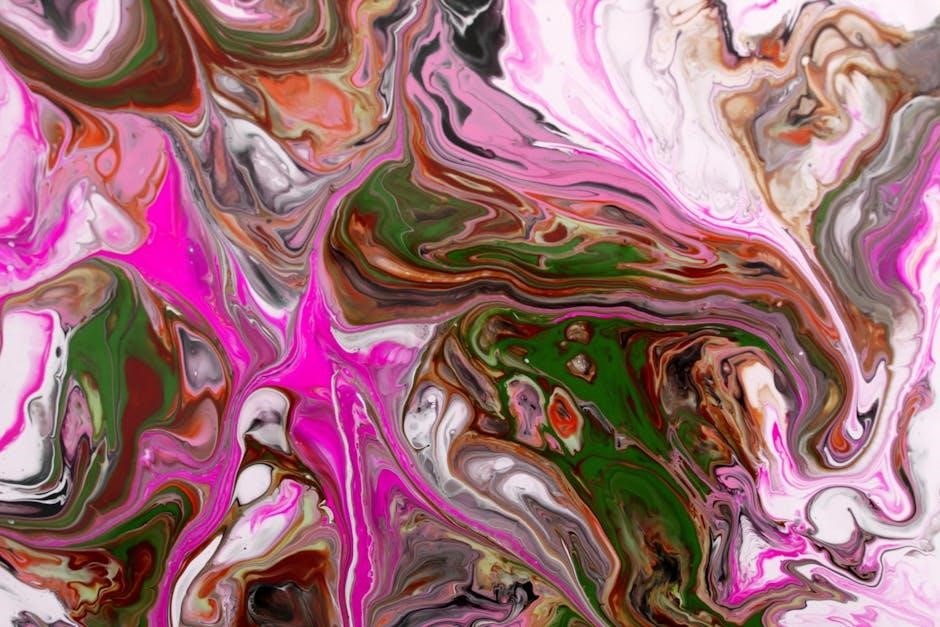This 60-minute Vinyasa Flow sequence is designed to enhance strength, flexibility, and balance, offering a holistic practice that combines dynamic movement with mindful breathing techniques for all levels.
Overview of Vinyasa Flow Yoga
Vinyasa Flow Yoga is a dynamic and flowing style of practice that links movement with breath, creating a meditative and transformative experience. It emphasizes synchronizing breath with postures, transitioning smoothly between asanas to build internal heat, strength, and flexibility. This practice often includes sequences like Sun Salutations, which warm up the body and prepare it for more complex poses. Vinyasa Flow encourages mindfulness, balance, and awareness, making it accessible to all levels. It combines physical postures, breathing techniques, and mental focus to promote a holistic well-being experience, suitable for those seeking both physical challenge and relaxation. The fluid nature of Vinyasa Flow allows practitioners to connect deeply with their bodies and minds, fostering a sense of flow and inner harmony.
Benefits of a 60-Minute Practice
A 60-minute Vinyasa Flow practice offers a comprehensive workout that enhances physical, mental, and emotional well-being. It improves strength, flexibility, and cardiovascular health while fostering mindfulness and reducing stress. The continuous flow of postures synchronizes with breath, creating a meditative rhythm that quiets the mind. Regular practice boosts energy levels, enhances balance, and strengthens core muscles. It also promotes better circulation, detoxification, and overall physical alignment. Mentally, the practice cultivates focus, discipline, and self-awareness, helping to reduce anxiety and improve mood. The balanced structure of a 60-minute sequence allows for a thorough warm-up, peak poses, and a cooling down period, ensuring a safe and effective practice for all levels. This holistic approach makes it an ideal way to nourish both body and soul in a single session.

The 60-Minute Vinyasa Flow Sequence
This dynamic sequence combines breath-synchronized movements, Sun Salutations, balancing poses, twists, and inversions, creating a comprehensive flow that builds strength, flexibility, and mindfulness for all levels.
Opening: Meditation, Breathwork, and Intention
The practice begins with a serene opening sequence designed to center the mind and prepare the body. Start by finding a comfortable seated position, using props like cushions or blankets for support. Close your eyes and take a few deep breaths to create a sacred space for your practice. Guide yourself or students through a brief meditation, focusing on the sensation of the breath moving in and out of the body. This helps calm the nervous system and sets a mindful tone for the flow.
Next, incorporate breathwork, such as Nadi Shodhana (alternate nostril breathing) or Box Breathing, to balance the energy and prepare for movement. Conclude the opening with a moment of intention-setting, encouraging self-reflection or a personal mantra to guide the practice. This thoughtful beginning ensures a grounded and purposeful start to the 60-minute sequence.
Warm-Up: Reclining Bound Angle and Happy Baby Pose
Begin the physical practice with a gentle warm-up to awaken the body. Start with Reclining Bound Angle Pose (Supta Baddha Konasana), where you lie on your back, bring the soles of your feet together, and let your knees fall apart. Allow your chest to open and your spine to relax, breathing deeply for 5-7 breaths. This pose stretches the hips, pelvis, and lower back, preparing the body for movement.
Next, transition into Happy Baby Pose (Ananda Balasana). Hold your knees with your hands and gently rock from side to side, massaging your lower back into the mat. This pose releases tension in the spine and hips while engaging the core. Spend 5-8 breaths here, creating a sense of playfulness and ease. These opening postures set the foundation for a fluid and balanced flow, gradually increasing circulation and warmth in the body. This warm-up segment seamlessly transitions into the dynamic movement ahead.
Sun Salutations and Core Activation
Transition into Sun Salutations (Surya Namaskar) to build heat and fluidity in the body. Begin with Mountain Pose (Tadasana), then fold forward into Standing Forward Bend (Uttanasana). Step back into Plank, lower into Chaturanga, press up into Upward-Facing Dog (Urdhva Mukha Svanasana), and end in Downward-Facing Dog (Adho Mukha Svanasana). Repeat this sequence 3-5 times, syncing breath with movement to create a dynamic flow. Modify by bending knees in Forward Bend or dropping knees in Plank for accessibility.
After Sun Salutations, activate the core with Boat Pose (Paripurna Navasana) and Plank variations. These poses strengthen the abdominal muscles, improving stability and preparing the body for more complex postures. Spend 5-8 breaths in each pose, focusing on precise alignment and controlled breathing. This segment builds internal heat and endurance, setting the foundation for the flowing sequence ahead.
Standing Poses: Balancing and Strength Building

Move into standing poses to build strength and stability; Begin with Warrior I (Virabhadrasana I) and Warrior II (Virabhadrasana II), holding each for 5 breaths to engage the legs and hips. Transition into Triangle Pose (Trikonasana) to open the spine and shoulders. Next, practice Eagle Pose (Garudasana) to refine balance and stretch the knees. Hold Tree Pose (Vrksasana) for 5-8 breaths, focusing on a steady gaze and grounded foundation. Conclude with Half Moon Pose (Ardha Chandrasana) to challenge balance and strengthen the core. Spend 5-10 breaths in each pose, using modifications like blocks or the wall for support. This segment enhances balance, builds leg strength, and prepares the body for deeper postures ahead;
Twists and Backbends
Transition into seated twists to enhance spinal flexibility and detoxify the body. Start with Seated Spinal Twist (Bharadvajasana), holding for 5-8 breaths on each side. Move into Cat-Cow (Marjaryasana-Bitilasana) to warm up the spine dynamically. Shift to Sphinx Pose (Salamba Bhujangasana) for a gentle backbend, holding for 5 breaths to open the chest and shoulders. Deepen the backbend with Wheel Pose (Urdhva Dhanurasana) for 3-5 breaths, using modifications if needed. Conclude with Seated Forward Fold (Paschimottanasana) to cool down and stretch the entire back side of the body. Spend 5-8 breaths here, focusing on surrender and release. This segment improves spinal mobility, strengthens back muscles, and prepares the body for deeper postures ahead.
Inversions and Cool Down
Begin with gentle inversions to refresh the body and calm the mind. Start with Downward-Facing Dog (Adho Mukha Svanasana) for 5 breaths, then transition into Legs-Up-The-Wall Pose (Viparita Karani) for 8-10 breaths to promote venous return and relaxation. For a deeper inversion, practice Shoulder Stand (Viparita Dandasana) for 5-8 breaths, followed by Plow Pose (Halasana) for 5 breaths to stretch the neck and shoulders. Conclude with Seated Forward Fold (Paschimottanasana) for 8 breaths to release tension. Use deep, rhythmic breathing to transition smoothly between poses. This segment prepares the body for Savasana, encouraging relaxation and rejuvenation. Modify poses as needed to ensure comfort and safety, especially for those new to inversions. End with a brief period of stillness to seal the practice and restore balance.

Modifications and Variations for All Levels

This sequence offers adjustments and variations to cater to all skill levels, ensuring a balanced practice for both beginners and advanced practitioners seeking relaxation or intensity.
Beginner-Friendly Adjustments
For beginners, modifications are essential to ensure a safe and enjoyable practice. Use blocks or straps to support poses like Triangle or Forward Fold. Replace complex balances with seated or wall-supported alternatives. Swap challenging poses like Crow or Headstand with simpler options like Seated Forward Bend or Child’s Pose. Break Sun Salutations into slower, breath-focused movements, pausing between poses if needed. Substitute deep twists or backbends with gentle seated versions, prioritizing comfort over intensity. Encourage resting in Child’s Pose during transitions to recharge. These adjustments allow newcomers to build confidence and strength gradually, fostering a positive experience and promoting proper alignment and breathing techniques. Always emphasize listening to the body and honoring its limits. The goal is to create a nurturing environment for growth and mindfulness.
Advanced Options for Deepening the Practice
For advanced practitioners, the 60-minute Vinyasa Flow sequence offers opportunities to deepen strength, flexibility, and focus; Incorporate dynamic variations of Sun Salutations, such as adding high lunge twists or binds to intensify the flow. Introduce advanced transitions, like floating from Crow Pose to Forward Fold, to enhance fluidity and challenge coordination. Deepen twists with intricate binds or spinal rotations, and explore backbends like Wheel or Scorpion Pose for greater opening. Include inversion variations, such as Handstand or Forearm Stand, to build strength and confidence. Add balancing poses like Eagle or Tree Pose, holding them longer to refine focus and stability. These advanced options allow practitioners to push their limits while maintaining mindful awareness and proper alignment, fostering a more immersive and transformative practice. Encourage exploring peak poses and complex flows to elevate the sequence’s intensity and depth. Always emphasize preparation, engagement, and honoring the body’s capabilities to ensure safe and effective progression.
The 60-minute Vinyasa Flow sequence concludes with a rejuvenating Savasana, allowing the body to absorb the practice’s benefits. Final breathwork and gratitude cultivate mindfulness and calm, leaving you refreshed and centered.
Importance of Savasana
Savasana, or Corpse Pose, is a vital concluding practice in the 60-minute Vinyasa Flow sequence. It allows the body to relax deeply, rejuvenating the mind and spirit. By surrendering all tension, Savasana promotes a profound sense of calm and renewal. This pose is essential for integrating the benefits of the practice, as it calming the nervous system and restoring energy. Regular inclusion of Savasana enhances overall well-being, making it a cornerstone of a holistic yoga practice;
Final Breathwork and Gratitude
Final breathwork and gratitude practices are essential for concluding a 60-minute Vinyasa Flow sequence. These moments allow for reflection and appreciation, fostering a sense of inner peace. By focusing on deep, conscious breathing, participants can calm their minds and integrate the practice’s benefits. Expressing gratitude, whether silently or aloud, cultivates positivity and awareness. This closing segment encourages mindfulness and sets a mindful tone for the rest of the day. It is a powerful way to honor the body’s efforts and acknowledge the journey of the practice, leaving participants feeling centered and renewed.